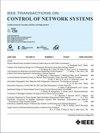隐形攻击下网络控制系统的安全分配
IF 4
3区 计算机科学
Q2 AUTOMATION & CONTROL SYSTEMS
引用次数: 0
摘要
本文研究了网络控制系统在隐身攻击下的安全分配问题。该系统由由顶点表示的相互连接的子系统组成。恶意攻击者选择单个顶点进行隐蔽的数据注入攻击,目的是在不被发现的情况下最大限度地破坏远程目标顶点。防御者在几个选定的顶点上分配对抗对手的防御资源。首先,将目标不确定的敌方和防御方的目标以概率的方式制定,从而得出隐形攻击的预期最坏情况影响。其次,我们给出了一个图论的充要条件,在这个充要条件下,防御者的代价和隐形攻击的预期最坏影响是有界的。这个条件使防御者能够将可接受的动作限制在表示网络的图的支配集上。然后,通过Stackelberg博弈论框架解决了安全分配问题。最后,通过一个50顶点网络控制系统的数值算例验证了所得结果。本文章由计算机程序翻译,如有差异,请以英文原文为准。
Security Allocation in Networked Control Systems Under Stealthy Attacks
In this article, we consider the problem of security allocation in a networked control system under stealthy attacks. The system is comprised of interconnected subsystems represented by vertices. A malicious adversary selects a single vertex on which to conduct a stealthy data injection attack with the purpose of maximally disrupting a distant target vertex while remaining undetected. Defense resources against the adversary are allocated by a defender on several selected vertices. First, the objectives of the adversary and the defender with uncertain targets are formulated in a probabilistic manner, resulting in an expected worst-case impact of stealthy attacks. Next, we provide a graph-theoretic necessary and sufficient condition under which the cost for the defender and the expected worst-case impact of stealthy attacks are bounded. This condition enables the defender to restrict the admissible actions to dominating sets of the graph representing the network. Then, the security allocation problem is solved through a Stackelberg game-theoretic framework. Finally, the obtained results are validated through a numerical example of a 50-vertex networked control system.
求助全文
通过发布文献求助,成功后即可免费获取论文全文。
去求助
来源期刊

IEEE Transactions on Control of Network Systems
Mathematics-Control and Optimization
CiteScore
7.80
自引率
7.10%
发文量
169
期刊介绍:
The IEEE Transactions on Control of Network Systems is committed to the timely publication of high-impact papers at the intersection of control systems and network science. In particular, the journal addresses research on the analysis, design and implementation of networked control systems, as well as control over networks. Relevant work includes the full spectrum from basic research on control systems to the design of engineering solutions for automatic control of, and over, networks. The topics covered by this journal include: Coordinated control and estimation over networks, Control and computation over sensor networks, Control under communication constraints, Control and performance analysis issues that arise in the dynamics of networks used in application areas such as communications, computers, transportation, manufacturing, Web ranking and aggregation, social networks, biology, power systems, economics, Synchronization of activities across a controlled network, Stability analysis of controlled networks, Analysis of networks as hybrid dynamical systems.
 求助内容:
求助内容: 应助结果提醒方式:
应助结果提醒方式:


